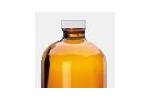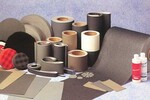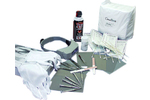- ▶
- Heaters/Source
- ▶
- Agilent Heaters and SensorsMass Spectrometry, Scientific Supplies & ManufacturingScientific Instrument Services 5973 Source Heater Tamper Resistant Allen Wrench 5973/5975 Quad Sensor 5985 Source Heater Assembly Agilent Interface Heater Assembly 5971 Interface Heater

- ▶
- MS Instrument Cleaning Supplies
- Lab/CleanMicro-Mesh® (Fine Cushioned Abrasive) Aluminum Oxide Cleaning Abrasive Fiberglass Cleaning Brushes Swabs and Applicators Nylon and Latex Gloves Cleaning Wipes SIS MS Source Cleaning Kits Dust-Off® Hurricane Canless Air System Wheaton Bottles Wheaton Vials Wheaton Closures Sterile Vials - Bottle, Stopper, and Cap - All Together Certified Sterile Kimble Chase Clear Serum Vials Soil Sampling Kits Crimpers and Decappers Temperature Measurement & Recording Devices Bullet Blender® Homogenizer The SW 110 Multi-Purpose Spot Welder New Era Syringe Pump Systems Ohaus MB Series Moisture Analyzers Celestron® Handheld Digital Microscope (HDM) Checkit® Pipette Accuracy Test Greenwood Lab Supplies Next Advance Lab Products Catalog Page G1

- ▶
- Micro-Mesh®Sheets Rolls Discs Pads Nail Files Tufbuf Micro-Gloss Tape Belts Sanding Swabs Polishing Tool Quick-Shine Buffers Kits - Plastic (power) Kits - Plastic (hand) Kits - Craftsman, Wood, Metal Kits - Automotive & Headlight Restoration Kits Kits - Aircraft Window Reference - Grit Size Reference - MSDS Sheets, Brochures, Instructions, Kits Print Catalog - Micro-Mesh Catalog Page A63 Catalog Page A64 Catalog Page A65 Catalog Page A66 Catalog Page G3 Catalog Page G4 Catalog Page G5 Catalog Page G6 Catalog Page G7 Catalog Page G8

- LiteratureApplication Notes Adsorbent Resins Guide Mass Spec Tips SDS Sheets FAQ MS Calibration Compound Spectra Manuals MS Links/Labs/ Organizations MS Online Tools Flyers on Products/Services Scientific Supplies Catalog About Us NextAdvance Bullet Blender® Homogenizer Protocols Micro-Mesh® Literature Instrumentation Literature Agilent GC/MS Literature SIS News / E-Mail Newsletter NIST MS Database - Update Notifications

- ▶
- Reference - MSDS Sheets, Brochures, Instructions, KitsMicro-Mesh Regular - Description of Micro-Mesh Regular Micro-Mesh MX - Description of Micro-Mesh MX for Metal Finishing Benefits of Micro-Mesh - What Makes Micro-Mesh So Special Ergonomic Benefits of Micro-Mesh - Human Factors, Engineering and Micro-Mesh TufBuf Polishing Pads - Polishing and Buffing Pads Guidelines for Acrylic Finishing Guideline for Making Belts with Micro-Mesh Micro-Gloss Instructions Metal Finishing with Micro-Mesh Random Orbital sanding with Micro-Mesh Solid Surface Finishing with Micro-Mesh Urethane Coating rectification Procedures Wood Finishing Procedures with Micro-Mesh Micro-Mesh Grit Size Conversion Chart Aquarium Restorer Kit Instructions Belt Finishing with Micro-Mesh Burn Kit Instructions Clear Seas Acrylic Kit Instructions Clear Seas Vinyl Kit Instructions Craft Kit Instructions Heavy Damage Removal Kit Instructions Light Damage Removal Kit Instructions KR-70 Acrylic Restoration Kit Instructions Maintenance Kit Instructions Micro-Mesh Anti-Static Cream Final Finish Micro-Finish Micro-Gloss Micro-Gloss # 5 TufBuf Polishing Pad

- ▶
- Belt Finishing with Micro-Mesh (This Page)
MICRO-MESH® finishing belts provide desired surface qualities and economic benefits to many types of finishing operations, and are available in a range of standard as well as custom sizes.
Generally recommended for fine finishing steps, MICRO-MESH is constructed with a
thin layer of soft resilient material between the cloth back and the abrasive
crystals which provide the unique "cushioned" suspension action for the
abrasive. This unique design allows the abrasive crystals to recede into the
resilient layer and align at an even cutting plane. This eliminates deep random
scratching and results in uniform scratch patterns and significantly longer
product life than conventional abrasives.
MICRO-MESH cuts rapidly due to its larger crystals. This design allows more
abrasive crystals to contact the work piece. MICRO-MESH outlasts conventional
abrasives because the relatively large crystals do not load up, fracture or
generate heat into the work piece.
Equipment
MICRO-MESH belts work well with almost any of type floor or bench machines including centerless, flat belt and platen sanders. Since regulating speed and pressure is difficult with portable belt sanders, they are not recommended. It is generally more effective to take the part to the machine, rather than the machine to the part.
Speed
In general, surface belt speed should be set at less than 5500 surface feet per minute (SFPM). Harder materials typically are run at 3000 - 5000 sfpm while 2500 - 3000 sfpm is better for softer metals, such as brass. Even softer materials such as plastic, should run at 600 - 1000 sfpm and should always be worked wet. Too great a speed and/or pressure will ultimately defeat the cushioning system.
Pressure
For best results, pressure should be kept light. The work of the MICRO-MESH belts is done with the abrasive crystal tips, very similar to the action of a brush. Increased pressure either by the operator or mechanically will cause stretching, premature wear of belts and unsatisfactory results.
Lubrication
The use of a very light water mist on the MICRO-MESH belt is recommended. This
mist should be applied at the opposite end of the belt from the contact wheel,
allowing the belt to feed the water forward to the part. The amount of mist used
should be adjustable. The belt should be wet to the touch where the part
contacts the belt, but not flooded. Generally if the proper amount of water is
used, no water should be dripping off the belt at any point.
Water is the best lubricant/coolant to use for all materials except aluminum.
Where flash rusting is a problem, as with ferrous parts, an inorganic rust
inhibitor such as sodium dichromate can be added to the water. Many organic rust
inhibitors contain solvents that may cause crystal loss or delamination. It is
always recommended to test any water additive's compatibility with a scrap piece
of MICRO-MESH.
Belt "grease" compounds should never be used on MICRO-MESH. Grease fills the
abrasive crystals and particles of material removed (swarf) will pack into the
grease, loading the MICRO-MESH and rendering it totally useless. Such belt
compounds are used to soften the cut of common abrasives and to lubricate. The
use of grease compounds is not recommended with MICRO-MESH.
Process
The finishing process used for a given part depends on such factors as beginning
surface condition of the part, finish desired, and the type of material being
finished. Surface evaluation is a matter of experience, trial and error.
If the surface of the part is too rough, a common abrasive belt may be necessary
to bring the surface to a starting point MICRO-MESH can handle in a
time-effective manner. However, since common abrasives usually leave random
scratches deeper than the grit size of the belt, it is better to start with as
fine a grit as possible for deburring or roughing steps. The random scratches
can then be more easily removed with the initial MICRO-MESH step.
06/01/02


